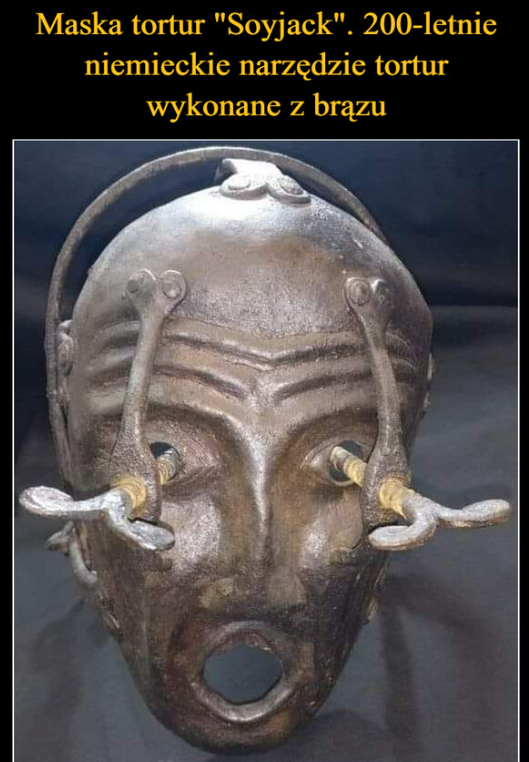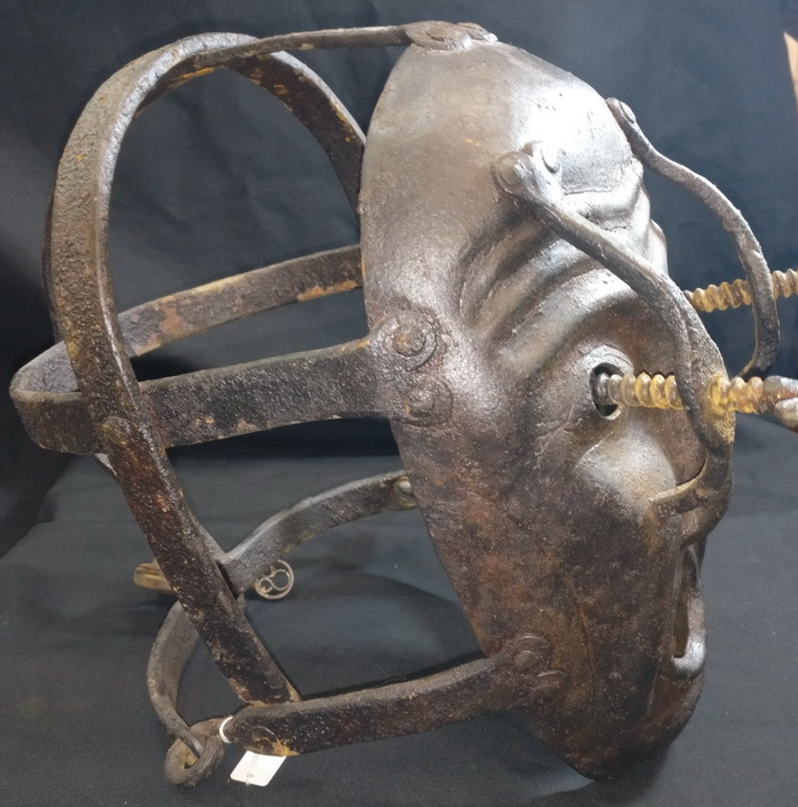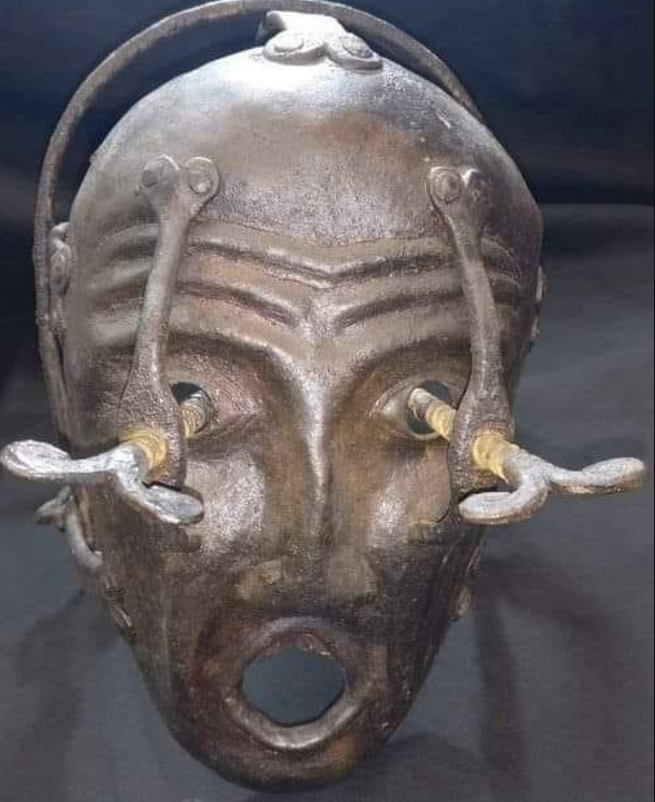Torture devices, grim artifacts of humanity’s past, provide chilling insights into methods of punishment and control used centuries ago. Among these relics, the Soyjack torture mask, a 200-year-old bronze tool from Germany, stands out as a haunting reminder of the darker chapters in European history. This device, with its menacing design and purpose, serves as both a historical artifact and a cautionary tale about the misuse of power and the extremes of human cruelty. Follow archeology.dulichvn.net to explore this ancient mask.
Origins and History of the Soyjack Torture Mask
The Historical Context
The Soyjack torture mask emerged during an era when public punishment was a common method of maintaining order. In 18th and early 19th-century Europe, corporal punishment and humiliation were used to enforce societal norms and deter crime. The mask, made of durable bronze, reflects the craftsmanship of the time, coupled with a chilling purpose.

Torture masks like the “Soyjack” were often used to punish individuals accused of blasphemy, slander, or other social transgressions. Their design aimed to inflict psychological torment and public humiliation, serving as a stark warning to others.
Why the name “Soyjack”?
Although the exact origins of the term “Soyjack” in connection to this mask are unclear, the moniker may be a modern association derived from contemporary memes or caricatures. The historical artifact itself likely had no such name but has gained notoriety through modern reinterpretations and discussions.
Material and Craftsmanship
Made of bronze, the mask demonstrates a duality of artistry and cruelty. The durable metal ensured the mask’s longevity and effectiveness, while its intricate design reflected the skilled metalworking of the period. Despite its grim purpose, the mask is a testament to the craftsmanship of its time.
See more: The Mercury Train: A Streamlined Masterpiece of Midwest Rail Travel
The Function and Impact of Torture Masks
Psychological Torment
The primary purpose of the Soyjack torture mask was to inflict psychological suffering. When worn, the mask would cover the face, often including exaggerated or grotesque features that dehumanized the wearer. Victims were paraded in public, subjected to ridicule, and ostracized by their communities.

The mask’s weight and tight fit added to the physical discomfort, creating a combined effect of shame, fear, and pain. This psychological punishment was often considered more impactful than physical torture, as it targeted the victim’s dignity and social standing.
Public Spectacle and Deterrence
Torture masks like this one were not used in isolation. They were part of broader public displays meant to deter others from committing similar offenses. Victims might be placed in stocks or marched through towns, ensuring maximum visibility and humiliation.
The fear instilled by such punishments contributed to societal compliance but also highlighted the oppressive nature of the ruling authorities. The Soyjack Torture Mask stands as a symbol of this era’s reliance on fear and control.
Social and Cultural Implications
The use of torture masks reflects the cultural values and judicial practices of the time. In many cases, they were employed to suppress dissent or enforce moral standards. Their existence underscores the harsh realities of justice systems that prioritized conformity over compassion.
See more: The Nefertiti Bust: A Masterpiece of Beauty and Controversy
Legacy and Lessons from the “Soyjack” Torture Mask
Preservation of Historical Artifacts
The “Soyjack” torture mask, like other historical torture devices, is preserved today as a reminder of the darker aspects of human history. Museums and private collections house such artifacts to educate future generations about past injustices and the evolution of human rights.

Preserving the mask serves as a warning against repeating the mistakes of history. It also provides valuable insights into the societal and judicial practices of the time, offering a lens through which we can examine progress and regression in human behavior.
Ethical Considerations in Displaying Torture Devices
Displaying artifacts like the Soyjack torture mask raises ethical questions. While they are valuable for education and historical understanding, their presentation must balance respect for victims with the need to confront uncomfortable truths.
Curators often contextualize these devices within broader narratives of human rights and social justice, ensuring they are not sensationalized but instead serve as tools for reflection and learning.
A Cautionary Tale for Modern Times
The legacy of the Soyjack torture mask extends beyond its historical context. It serves as a powerful symbol of the dangers of unchecked authority and the dehumanization of individuals. In a modern world grappling with issues of justice and human rights, this artifact reminds us of the importance of empathy, dignity, and restraint in societal governance.
See more: The Bicycle in 1946: A Visionary Concept Ahead of Its Time
Conclusion: Unmasking the Lessons of History
The Soyjack torture mask is more than a relic of the past—it is a stark reminder of the lengths to which societies have gone to enforce order and control. Its bronze structure, both artistic and terrifying, encapsulates a time when public humiliation was a tool of justice and fear ruled over compassion.
As we reflect on this artifact, we are reminded of the progress humanity has made and the work that still lies ahead. The Soyjack torture mask challenges us to confront the darker aspects of our history and to strive for a future where dignity and justice prevail. Through education and preservation, this grim symbol of the past becomes a beacon for building a more compassionate and equitable world.

CÁC TIN KHÁC
Mark Twain & Olivia Langdon: A 36-Year Love Story Filled with Laughter and Devotion
The Tollund Man: A 2,400-Year-Old Mystery Preserved in a Danish Bog
Skara Brae: Scotland’s Hidden Neolithic Village
Porta Nigra: The Hidden Depths of Trier’s Iconic Roman Gate